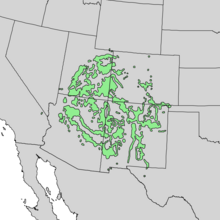Pinus edulis
| Pinus edulis | |
|---|---|

| |
| Colorado pinyons at Bryce Canyon National Park | |
| Scientific classification | |
| Kingdom: | Plantae |
| Clade: | Tracheophytes |
| Clade: | Gymnospermae |
| Division: | Pinophyta |
| Class: | Pinopsida |
| Order: | Pinales |
| Family: | Pinaceae |
| Genus: | Pinus |
| Subgenus: | P. subg. Strobus
|
| Section: | P. sect. Parrya
|
| Subsection: | P. subsect. Cembroides |
| Species: | P. edulis
|
| Binomial name | |
| Pinus edulis | |

| |
| Natural range of Pinus edulis | |
Pinus edulis, the Colorado pinyon, two-needle piñon, pinyon pine, or simply piñon,[2] is a pine in the pinyon pine group native to the Southwestern United States, used for its edible pine nuts.
Distribution and habitat
The range in the U.S. is in
There is one known example of a Colorado pinyon growing amongst Engelmann spruce (Picea engelmannii) and limber pine (Pinus flexilis) at nearly 3,170 metres (10,400 ft) on Kendrick Peak in the Kaibab National Forest of northern Arizona.
Description
The piñon pine (Pinus edulis) is a small to medium size
The cones are globose, 3–5 cm (1+1⁄4–2 in) long and broad when closed, green at first, ripening yellow-buff when 18–20 months old, with only a small number of thick scales, with typically 5–10 fertile scales. The cones open to 4–6 cm (1+1⁄2–2+1⁄4 in) broad when mature, holding the seeds on the scales after opening. The seeds are 10–14 mm (3⁄8–9⁄16 in) long, with a thin shell, a white endosperm, and a vestigial 1–2 mm (1⁄32–3⁄32 in) wing.
The species intermixes with Pinus monophylla sbsp. fallax (see description under Pinus monophylla) for several hundred kilometers along the Mogollon Rim of central Arizona and the Grand Canyon resulting in trees with both single- and two-needled fascicles on each branch. The frequency of two-needled fascicles increases following wet years and decreases following dry years.[5] The internal anatomy of both these needle types are identical except for the number of needles in each fascicle suggesting that Little's 1968 designation [6] of this tree as a variety of Pinus edulis is more likely than its subsequent designation as a subspecies of Pinus monophylla based entirely upon its single needle fascicle.
It is an aromatic species. Essential oil can be extracted from the trunk, limbs, needles, and seed cones. Prominent aromatic compounds from each portion of the tree include α-pinene, sabinene, β-pinene, δ-3-carene, β-phellandrene, ethyl octanoate, longifolene, and germacrene D.[7]
-
Cones of P. edulis
-
Foliage
-
Trunk
Ecology
The seeds are dispersed by the pinyon jay, which plucks them out of the open cones. The jay, which uses the seeds as a food resource,[8] stores many of the seeds for later use, and some of these stored seeds are not used and are able to grow into new trees. The seeds are also eaten by wild turkey, Montezuma quail, and various mammals.[9]
History
Colorado pinyon was described by George Engelmann in 1848 from collections made near Santa Fe, New Mexico on Alexander William Doniphan's expedition to northern Mexico in 1846.
It is most closely related to the
An isolated population of trees in the
Uses
The
Archaeologist Harold S. Gladwin described pit-houses constructed by southwestern Native Americans c. 400–900 CE; these were fortified with posts made from Pinyon trunks and coated with mud.[11]
Colorado pinyon is also occasionally planted as an ornamental tree and sometimes used as a Christmas tree.
The piñon pine (Pinus edulis) is the
See also
References
- . Retrieved 19 November 2021.
- ^ "New Mexico Secretary of State: KID'S Corner". Archived from the original on 2008-05-01. Retrieved 2009-05-09.
- ISBN 978-1-4027-3875-3.
- ^ Rehorn, John T. (Winter–Spring 1997). "The Gift". American Forests. 103 (1): 28 caption.
- PMID 21188300.
- ^ Little, Elbert (1968). "Two new pinyon varieties from Arizona". Phytologia. 17: 329–342.
- ^ Poulson A, Wilson TM, Packer C, Carlson RE, Buch RM. "Essential oils of trunk, limbs, needles, and seed cones of Pinus edulis (Pinaceae) from Utah". Phytologia. 102 (3): 200–207.
{{cite journal}}: CS1 maint: multiple names: authors list (link) - ^ ISBN 0-394-73127-1.
- ^ Bonanza Books. pp. 68–69.
- ^ Fischer, Karen (December 6, 2021). "In New Mexico, Money Grows on Trees". Eater. Retrieved December 6, 2021.
- Bonanza Books. p. 70.
- Ronald M. Lanner, 1981. The Piñon Pine: A Natural and Cultural History. University of Nevada Press. ISBN 0-87417-066-4.
- 12Schellbach, Louis III, 1933. Indian Use of the Pinyon Pine in the Grand Canyon Region. Grand Canyon National Park. vol8-9c.htm. 14-Oct-2011.
External links
 Media related to Pinus edulis at Wikimedia Commons
Media related to Pinus edulis at Wikimedia Commons Data related to Pinus edulis at Wikispecies
Data related to Pinus edulis at Wikispecies- Gymnosperm Database: Pinus edulis




